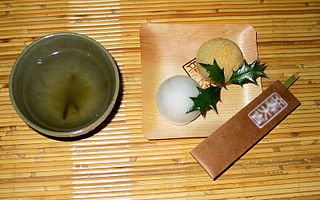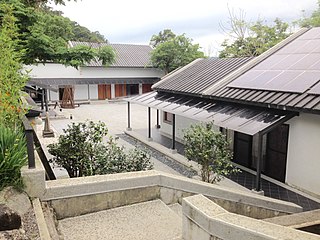 W
WTea is a beverage made from the leaves of tea plants and boiled water. Tea leaves are processed using traditional Chinese methods. Chinese tea is consumed throughout the day, including during meals, as a substitute for plain water, well-being or for simple pleasure.
 W
WThis is a list of Chinese teas. Chinese tea is a beverage made from the leaves of tea plants and – depending on the type of tea – typically 60–100 °C hot water. Tea leaves are processed using traditional Chinese methods. Chinese tea is drunk throughout the day, including during meals, as a substitute for plain water, for health, or for simple pleasure.
 W
WAll in This Tea is a 2007 documentary film co-directed by Les Blank and Gina Leibrecht, about Chinese tea. It follows the American tea connoisseur David Lee Hoffman as he travels to remote tea-growing areas of China. Hoffman attempts to interest Chinese tea growers and distributors in fair trade issues, and explores the importance of terroir and organic growing methods in both the quality and future sustainability of the Chinese tea market.
 W
WArrowroot tea, also called kudzu tea, is a traditional East Asian tea made from East Asian arrowroot, a type of kudzu.
 W
WBarley tea is a roasted-grain-based infusion made from barley. It is a staple across many East Asian countries such as China, Japan, and Korea. It has a toasty, slightly bitter flavor.
 W
WThe China National Tea Museum is located in Hangzhou, Zhejiang province, China. The exhibitions display tea production, and different kinds of tea. Exhibitions are in Chinese and English languages.
 W
WFermented tea is a class of tea that has undergone microbial fermentation, from several months to many years. The exposure of the tea leaves to humidity and oxygen during the process also causes endo-oxidation and exo-oxidation. The tea leaves and the liquor made from them become darker with oxidation. Thus, the various kinds of fermented teas produced across China are also referred to as dark tea, not be confused with black tea. The most famous fermented tea is Pu-erh produced in Yunnan province.
 W
WFlowering tea or blooming tea consists of a bundle of dried tea leaves wrapped around one or more dried flowers. These are made by binding tea leaves and flowers together into a bulb, then setting them to dry. When steeped, the bundle expands and unfurls in a process that emulates a blooming flower, and the flowers inside emerge as the centerpiece. Typically they are sourced from the Yunnan province of China. Flowers commonly used in flowering teas include globe amaranth, chrysanthemum, jasmine, lily, hibiscus, and osmanthus.
 W
WGreen tea is a type of tea that is made from Camellia sinensis leaves and buds that have not undergone the same withering and oxidation process used to make oolong teas and black teas. Green tea originated in China, and since then its production and manufacture has spread to other countries in East and Southeast Asia.
 W
WKelp tea is a traditional East Asian tea made by infusing kelp in hot water. It is called kobu-cha or konbu-cha (昆布茶) in Japan, haidai-cha (海带茶) in China and dasima-cha (다시마차) in Korea.
 W
WMatcha is finely ground powder of specially grown and processed green tea leaves, traditionally consumed in East Asia. The green tea plants used for matcha are shade-grown for three to four weeks before harvest; the stems and veins are removed during processing. During shaded growth, the plant Camellia sinensis produces more theanine and caffeine. The powdered form of matcha is consumed differently from tea leaves or tea bags, as it is suspended in a liquid, typically water or milk.
 W
WOolong is a traditional semi-oxidized Chinese tea produced through a process including withering the plant under strong sun and oxidation before curling and twisting. Most oolong teas, especially those of fine quality, involve unique tea plant cultivars that are exclusively used for particular varieties. The degree of oxidation, which varies according to the chosen duration of time before firing, can range from 8 to 85%, depending on the variety and production style. Oolong is especially popular in south China and among Chinese expatriates in Southeast Asia as is the Fujian preparation process known as the Gongfu tea ceremony.
 W
WThe Ping-Lin Tea Museum, also spelled Pinglin Tea Museum, is a museum located in the hills of Pinglin District, New Taipei, Taiwan. It is one of the world's largest tea museums.
 W
WThe Taipei Story House, formerly known as the Yuanshan Mansion, is a historic house in the Zhongshan District, Taipei, Taiwan. It is now open as a museum in Taipei Expo Park.
 W
WWhite tea may refer to one of several styles of tea which generally feature young or minimally processed leaves of the Camellia sinensis plant.
 W
WYellow tea can refer to Chinese huángchá and Korean hwangcha.